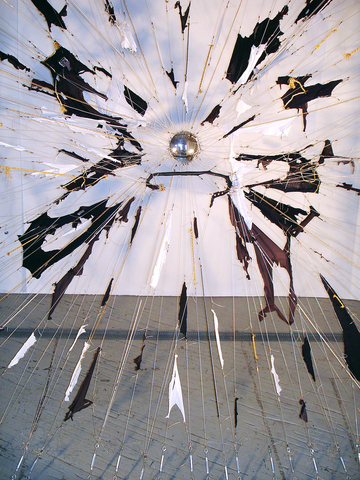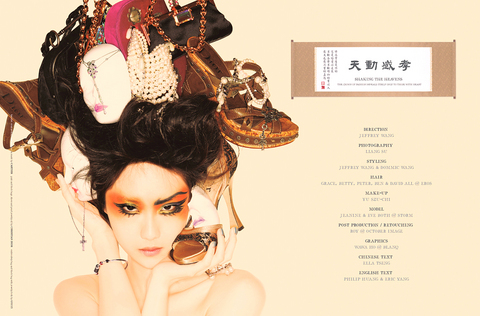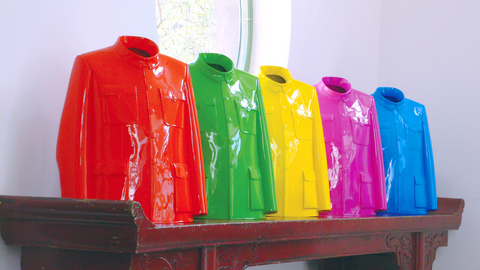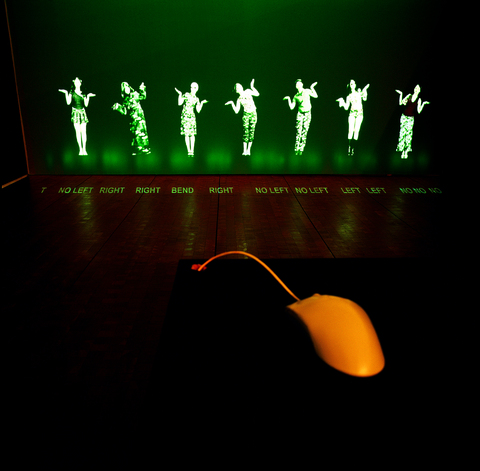New York's Guggenheim Museum mounted an exhibition in 1997 titled Fashion/Art, which examined the relationship between art and fashion in the 20th century.
That exhibit revealed how certain early 20th century art movements, such as Italian Futurism and Russian Constructivism, combined fashion with art as a means of complimenting their notions of a utopian society. By the mid-century, the distance between art and fashion were narrowed as Pop art merged the two in a conscious effort to erase the distance between high and low art. Since the 1960s, various artists have sought to undermine the fashion world's pretension to elegance by drawing attention to the industry's underbelly.
Sean Hu (胡朝聖), curator of MOCA's current exhibit titled Fashion Accidentally saw the Guggenheim exhibit and was inspired by the ideas expressed in the highly regarded show.

PHOTOS: COURTESY OF MOFA, TAIPEI
"Since then I have been collecting information related to clothing to find a context for this exhibition," he said after the exhibit's opening reception.
"I want to discuss this issue through semiology, sociology, psychology and also feminism ... and ... through clothing, respond to what is going on in our world, to what is happening at this moment."
Bringing together the work of 15 young artists from around the globe whose work covers a variety of media, the show is presented thematically and employs a political and humorous visual language that makes it accessible, though with enough resonance to appeal to those well-versed in critical theory.

Illustrating the relationship between feminine ideals and fashion is Jeffrey Wang's (王九思) witty 24 Xiao (二 十 四孝), a series of exquisitely rendered c-print posters that appropriate the traditional Chinese concept of filial piety. Taking idealized notions of how women should look, the artist fuses each image with objects of desire. The images are both decadent and banal in their use of symbols, and the artist employs a satirical visual language that is at once low and highbrow.
The commodification of Western images and their onslaught on Asian culture is humorously portrayed by Yasumasa Morimuras' series of large photos called Self-Portrait (Actress). The Japanese artist photographed himself dressed up as famous female movie stars, which effectively demonstrates the bizarre nature of gender issues and the often unspoken cultural hegemony that this entails. The artist has deliberately left obvious flaws in the pictures.
Humanity's cruelty and disrespect for life are the themes of Nicola Costantino's Human Furrier, where skin-like fabric and human hair are used to create a fictitious line of clothing that draws attention to our obsession with satisfying cravings for clothing. Taking a different approach with her line of fashion, Taiwan-based, American artist Susan Kendzulak explores relationships between humans in her installation Love/Hate. Juxtaposing her line of conjoined knitted apparel with a boxing ring shows how love is a messy, complex and intimate affair.

E.V. Day's installation titled Chanel/Shazam explodes — literally — a garment of Chanel clothing and then suspends the cotton shrapnel from fish wire. Harking back to 1960s and 1970s feminist thought, in which clothing is intimately tied up with freedom and subjugation, Day's work menacingly illustrates the predicament still faced by today's women.
Chinese artist Sui Jian-guo's (隋建國) sculpture titled Rainbow Jacket blends Sun Yat-sen's (孫中山) drab tunic suit — often misinterpreted as those worn by Mao Tse-tung (毛澤東) — with the psychedelic cover art of the Beatles' Sergeant Pepper album, and brings to light the ways in which China is both steeped in the past and opening to Western influences.
Harking back to 1990s militant political art, though still eminently topical, is Venezuelan artist Jose Antonio Hernandez-Diez' My Fucking Jeans, one of four installations that examines the relationship between highly paid designers and the cheap overseas labor that turns the images into products — items that the laborers themselves couldn't possibly afford.

Though the show has its roots in fashion history and serious political activism, it is more than a didactic exhibition and takes a humorous look at the accidents the world of fashion continues to make.


That US assistance was a model for Taiwan’s spectacular development success was early recognized by policymakers and analysts. In a report to the US Congress for the fiscal year 1962, former President John F. Kennedy noted Taiwan’s “rapid economic growth,” was “producing a substantial net gain in living.” Kennedy had a stake in Taiwan’s achievements and the US’ official development assistance (ODA) in general: In September 1961, his entreaty to make the 1960s a “decade of development,” and an accompanying proposal for dedicated legislation to this end, had been formalized by congressional passage of the Foreign Assistance Act. Two

Despite the intense sunshine, we were hardly breaking a sweat as we cruised along the flat, dedicated bike lane, well protected from the heat by a canopy of trees. The electric assist on the bikes likely made a difference, too. Far removed from the bustle and noise of the Taichung traffic, we admired the serene rural scenery, making our way over rivers, alongside rice paddies and through pear orchards. Our route for the day covered two bike paths that connect in Fengyuan District (豐原) and are best done together. The Hou-Feng Bike Path (后豐鐵馬道) runs southward from Houli District (后里) while the

On March 13 President William Lai (賴清德) gave a national security speech noting the 20th year since the passing of China’s Anti-Secession Law (反分裂國家法) in March 2005 that laid the legal groundwork for an invasion of Taiwan. That law, and other subsequent ones, are merely political theater created by the Chinese Communist Party (CCP) to have something to point to so they can claim “we have to do it, it is the law.” The president’s speech was somber and said: “By its actions, China already satisfies the definition of a ‘foreign hostile force’ as provided in the Anti-Infiltration Act, which unlike

Mirror mirror on the wall, what’s the fairest Disney live-action remake of them all? Wait, mirror. Hold on a second. Maybe choosing from the likes of Alice in Wonderland (2010), Mulan (2020) and The Lion King (2019) isn’t such a good idea. Mirror, on second thought, what’s on Netflix? Even the most devoted fans would have to acknowledge that these have not been the most illustrious illustrations of Disney magic. At their best (Pete’s Dragon? Cinderella?) they breathe life into old classics that could use a little updating. At their worst, well, blue Will Smith. Given the rapacious rate of remakes in modern